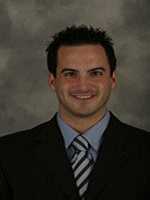The Hip & Pelvis: The Center of Attention
This post was written by H&W instructor Steve Dischiavi, MPT, DPT, ATC, COMT, CSCS. Dr. Dischiavi will be instructing the course that he wrote on "Biomechanical Assessment of the Hip and Pelvis" in Virginia this August.

In an outpatient sports medicine clinic the traditional model of physical therapy evaluation typically includes the therapist reviewing a patients chart and subjective symptom questionnaire of some sort. Then the therapist will bring the patient to an area to begin a subjective history and then onto a physical exam. After these procedures have been completed the therapist will typically assign a working clinical diagnosis and then begin treatment. In short, I would like to suggest a paradigm shift to this traditional model of thinking. Instead of starting the exam on a table with a static assessment of the structures involved and identifying the pain generator, I suggest the therapist begin with a specific set of movements used as an evaluative tool to identify movement dysfunction within the anatomical system as a whole.
All human interactions on earth occur between ground reaction force and gravity, our bodies are mostly just stuck in the middle of this constant battle and typically we succumb to whichever power exposes the weakest link in our biomechanical chains. One of the reasons the biomechanical chains in our bodies are so pliable and vulnerable to constant ground reaction force and gravity acting on them is because we are basically bones or struts suspended in a bag of skin all connected by soft tissue. Suggesting that without skin, fascia, and connective tissue supporting us, we would collapse to the ground in a pile of bones! Ingber (1997), suggested this concept, known as tensegrity, was the “architecture of life.” So in summary, the tensegrity structures are mechanically stable not because of the strength of the individual bones, but because of the way the entire human body distributes and balances mechanical stresses through the use of polyarticular muscle chains called slings. There will be more on slings in the upcoming blogs.
If there is truly a paradigm shift with the way we initially assess our clients and we begin our evaluations with whole system movement patterns it would be because we want to actually see how this tensgerity model is essentially collapsing under the stress of gravity. We would get a first hand glimpse in real time how energy leaks and blocks occur during human movement. These concepts are the foundation for the course Biomechanical Assessment of the Hip & Pelvis.
Ingber, D.E. (1997). Tensegrity: the architectural basis of cellular mechanotransduction.
Annual Review of Physiology, 59, 575-59.
Dr. Dischiavi's course is designed to elevate the participant’s skill level through advanced training in hip and pelvic biomechanics, functional “slings” created by the myofascial system, and through use of sports medicine theory and applied science. Biomechanical Assessment of The Hip & Pelvis will be taking place in August in Arlington, VA
By accepting you will be accessing a service provided by a third-party external to https://hermanwallace.com/




































